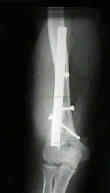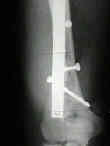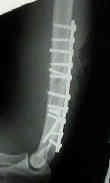- See:
- Fracture Dislocations of the Proximal Humerus
- Two Part Fractures
- Discussion:
- most common fracture of proximal humerus;
- frx is extracapsular, usually has an adequate blood supply and relatively low incidence of AVN;
- in contrast, anatomic neck frx has much higher incidence of AVN;
- upper fragment is usually abducted & externally rotated by muscles inserting onto greater tubercle, while lower fragment is adducted & internally rotated by internal rotators;
- stable vs unstable fractures:
- surgical neck fractures should be classified as either stable or unstable;
- unstable fractures may result from either low or high velocity forces;
- compression frxs tend to be stable,
- shear injuries tend to be unstable;
- periosteal tissue disruption leads to inscreased frx instability;
- unstable frx will display gross motion between shaft & head fragments;
- associated tuberosity frx:
- associated undisplaced frx into tuberosities are common, but they do alter natural history because the soft tissues are retained;
- Radiographs:
- eventhough the patient's arm will be tender to abduction, the axillary view often is the most important view (since it tends to show the most displacement);
- Non Operative Treatment:
- determination of stability:
- stability is present when the patient can actively move extremity w/o pain, & limb can be moved passively w/ little pain & no abnormal motion between fragments;
- flouroscopic exam may indicate lack of motion between shaft & prox fragment, implying intact soft tissue envelope and a stable frx;
- impacted stable fracture in which the shaft and head move as one unit;
- arm may be immobilized in a sling & early motion started immediately;
- reduction of surgical neck fractures:
- humeral shaft is usually displaced medially (by pull of pectoralis) & anteriorly by pectoralis;
- w/ a 2 part frx, both tuberosities are attached to humeral head along w/ intact rotator cuff allowing humeral head to remain in a neutral position;
- posterior periosteal hinge is frequently present and contributes to apex anterior angulation of the proximal shaft;
- left uncorrected, decr of forward elevation may comprimise f(x);
- immobilization is required until sufficient frx healing allows pt pain free motion, which may take from 2-6 weeks;
- severe pain & delayed union will require prolonged immobilization, which may lead to permanent stiffness;
- generally immbolization for more than 2 weeks will lead to shoulder stiffness;
- non impacted fractures are more likely to develop non union;
- Operative Treatment of 2 Part Surgical Neck Frx:

- reduction of surgical neck fractures:
- realize that most fractures will reduce in addition, but some surgical neck fractures will actually displace more in adduction;
- percutaneous pinning:
- as pointed out by Koval et al, Schanz pins provided the best form of fixation in osteoporotic bone;
- lateral plating: (synthes locking plate technique):
- IM Nailing:
- IM nail is often possible with some of the new IM nails w/ multiple "high" proximal interlocks;
- surgical neck fractures which reduce in adduction are more amenable to IM nailing than are surgical neck fractures which reduce in abduction (since the nail will have to be inserted in adduction);
- screw tension band technique:
- anterior approach to shoulder
- impaction of proximal humerus on shaft may be facilitated by scooping out a portion of cancellous
bone from humeral head & keying shaft into this defect;
- reduction:
- in some cases cancellous bone from the humerus head is removed to allow better impaction;
- fixation:
- head and shaft can then be fixed with K wires;
- 1.6 mm or 2 mm K wires are driven across main fragments w/ power drill;
- tuberosity fragments can also be fixed with K wires;
- tension band wire is then inserted around the K wires in tuberosities and inserted in shaft;
- alternatively, insert 4.5 or 6.5 mm cancellous lag screw from the shaft up into the head, just shy of the subchondral bone (use the countersink);
- following screw insertion, figure of 8 tension band wiring (consider No 5 Ethibond) is passed around the rotator cuff origin on the greater tuberosity to a drill hole made in the humeral shaft;
- a second wire is inserted thru both the lesser and greater tuberosities;
- reference:
Internal fixation of proximal humerus fractures using the screw-tension band technique.
- shoulder replacement
- Acute prosthetic replacement for severe fractures of the proximal humerus.
- Three Part Surgical Neck Fracture:
- DC plate may be supplemented by tension band wire, fixing tuberosity frags;
- w/ oblique frxs of surgical neck fracture consider placing, a lag screw thru the plate across the fracture line;
- two 6.5 mm cancellous screws inserted into subchondral bone inorder to fix proximal portion of the plate;
- screws should be fully threaded to increase their holding power
Operative versus non-operative treatment for two-part surgical neck fractures of the proximal humerus
Original Text by Clifford R. Wheeless, III, MD.
Last updated by Clifford R. Wheeless, III, MD on Saturday, August 10, 2013 9:04 pm




